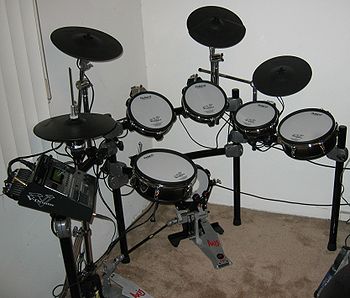 |
| A snare drum. (Photo credit: Wikipedia) |
Drumsticks can be made of many different types of materials but are usually made of wood. Common wood choices include hickory, oak, and hard maple. Each type of wood obtains unique characteristics that may make it more suitable in some musical situations than in others. Therefore, choosing the right wood for a performance is one key element to every drummer's unique tone.
Hickory tends to be the most popular wood used in drumsticks. It is denser, heavier and more rigid than the most types of wood allowing it to absorb a great amount of shock which helps reduce wrist and hand fatigue. Maple wood which is less dense and much lighter than hickory wood so it helps give the feel of a big stick without the extra weight of the hickory. Lastly, oak wood is very heavy and non-flexible causing the drumsticks made of oak to be some of the heaviest, hardest, and most durable drumsticks.
While the three types of wood mentioned above are the most common materials used to make drumsticks, other woods such as beech, hornbeam, lancewood, and massaranduba are also sources of snare drum sticks. It's important to note that sticks can also be made out of other materials including aluminum, plastic, and graphite, however, these are much rarer.
A snare drumstick has 4 basic parts but there will be 6 parts discussed in this article. First is the tip which is also known as the bead. It is located at the end part in which the head is being struck. It can be oval, round, acorn, or barrel-shaped. The shape of the bead can influence the way the stick rebounds off of the drum head after a stroke and is one of the most important aspects of a drumstick. Next is the neck of the drumstick. It is the small part of a snare drum stick that connects the tip to the shoulder. It is the thinnest part with the exception of some specialty drumsticks. The shoulder is the part where the stick starts to taper or slope into the neck. The closer the shoulder is to the tip, the less bounce and response you will get. The taper is used to identify the shape and the length of the drumstick shoulder. The shaft or the body is the biggest part of the stick which is used to hold and sometimes to produce specialty strokes. Lastly, the butt is the opposite of the tip which is the thicker, counterbalance end of the stick. Though it is not specifically designed as the part to play, some drummers flip the sticks to use butts for effects.
When picking out your first pair of snare drum sticks, be sure to consider the factors mentioned in this article. Determine what type of music you will be playing and decide what type of material will best fit that style of music. Next, determine what type of tip you want as well as what size drumstick best fits your hand. If you can feel confident making these decisions, you will have an easy time finding the perfect pair of sticks for your drumming experience!
Richard J. Klein is a passionate drummer and drum teacher who loves sharing his knowledge with people all around the world.
Article Source: EzineArticles |















